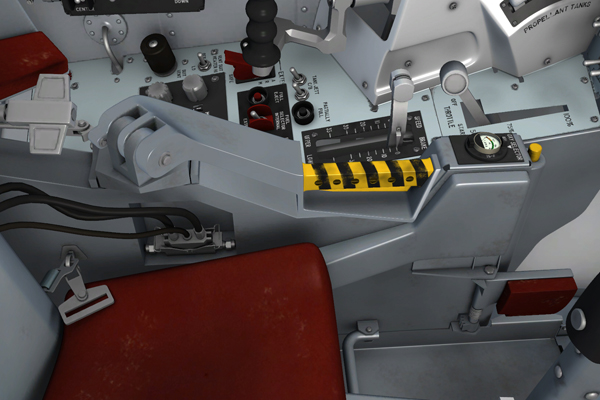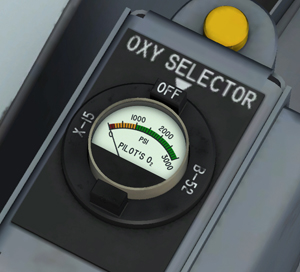
Left view of the seat showing the personal-leads disconnect and the pilot's oxygen selector and gauge. Breathing oxygen bottles are installed under the seat.
The pilot's oxygen system is a high-pressure (3000 psi), gaseous-type system, completely contained within the ejection seat and pilot's back pan.
Two 96-cubic-inch, lightweight cylinders are mounted on the bottom of the seat [4, fig. 4-2]. The charging valve for both cylinders is about 6 inches above the seat bucket on the back rest.
This system will supply 100 percent oxygen to the helmet for approximately 45 minutes at a pressure of 1½ inches of water above the pilot's suit pressure, which varies with altitude. A reducer valve, incorporated in the high-pressure line, reduces the cylinder pressure from 3000 psi to 70 to 90 psi at the pilot's personal-lead quick-disconnect [12, fig. 4-2]. The oxygen then flows into the back pan through a regulator and into the face mask.
The system includes a warning system to indicate when breathing oxygen pressure is approaching the minimum for which the pressure suit is designed to permit normal breathing.
No dilution is required in this system.
Breathing oxygen is supplied by the carrier airplane from take-off until just before launch, at which time the pilot selects the X-15 airplane oxygen supply. The oxygen supply is also utilized to pressurize the pilot's pressure suit in case the nitrogen ventilation and pressurization supply should fail.
If ejection is necessary, the complete oxygen system is retained with the seat.
Note: The canopy and the seat cannot be ejected in this software version.
Immediately before ejection, the green ball on the upper right side (chest area) of the pressure suit should be pulled to activate the emergency oxygen system and maintain suit pressurization after separation from the seat. When the green ball is pulled, the oxygen in the back pan flows through a pressure reducer, on through an oxygen regulator and a pressure suit regulator, to the pressure suit and helmet. The emergency oxygen supply, contained in the back pan, has a capacity of about 100 cubic inches at a cylinder pressure of 1800 psi and for a duration of about 20 minutes.
Note: Pilot's oxygen pressure can be monitored on the system monitor panel.
During the time interval between seat separation from the airplane and pilot separation from the seat, the breathing oxygen is drawn from the normal system oxygen bottles attached to the seat. This is made possible by a valve in the emergency system, which is kept closed by a pressure differential until the pilot separates from the seat.

Pilot's oxygen system selector and pressure gauge.
A three-position oxygen system selector, mounted on the forward end of the left side panel of the seat [18, fig. 4-2], allows pilot selection of two separate oxygen systems. The three positions, labeled "B-52", "OFF" and "X-15," depend on the phase of flight as to which system is selected.
The control head is a round, tubular aluminum section with the oxygen pressure gauge mounted in the center. The selector is positioned by turning it from the middle OFF position, either right or left, to select the desired system (X-15 or B-52).
The gauge range is from 0 to 3000 psi. Permanent markings are on the range scale. There is a red radial at 200. a yellow arc from 200 to 1000, and a green arc from 1000 to 3000. If the breathing oxygen is depleted to the point where the gage pointer is at 200, the green ball on the pilot's pressure suit must be pulled to actuate the emergency breathing oxygen supply.
The pilot's oxygen-low caution light [6, fig. 5-1] is on the instrument panel, directly above the airspeed/Mach indicator [5, fig. 5-1]. The placard-type amber light is powered by the primary DC bus and when illuminated reads "PILOTS 02 LOW". It comes on when breathing oxygen pressure downstream of the reducer valve drops to about 60 psi. When the light comes on, the pilot is alerted to the possibility of encountering oxygen supply pressure sufficiently low to ultimately result in breathing difficulty.
In this section:
Normal Operation of Pilot's Oxygen System
Emergency Operation of Pilot's Oxygen System
See also: